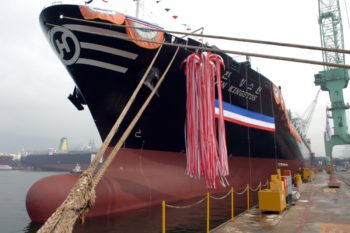
While there was a slight rise in rates at the end of last year after the Hanjin Shipping collapse, this was not sustained and lines will have to make hard financial decisions this year to ensure their survival.
These were the findings of the latest AlixPartners Annual Container Shipping Study that warned the outlook for global container carriers remains rocky at the outset of 2017.
AlixPartners cautioned that Brexit and the new US administration’s policies threaten to inject further uncertainty into the future of global trade and that these protectionist stances could reverse policies that have supported the growth of containerization since the 1950s.
“The industry remains in the midst of major upheaval it’s experienced since the 2008 financial crisis. Carriers need to remain focused on eliminating costs from their core shipping business,” said AlixPartners md Esben Christensen.
“While there has been good news recently in rates, the industry still needs to be prepared for continued struggles. The recent consolidation isn’t the cure all for the industry.” Going into the key transpacific rates period, companies need to do everything they can to retain the higher rates recently seen, the report noted.
AlixPartners did point out that rate levels on major East-West trades improved, dramatically in some cases, in the fourth quarter of last year. This bodes well for fourth quarter results as carriers were also able to sustain those higher rate levels because of an unusually early Chinese New Year.
“Spot rates rose nicely after Hanjin ceased operations, particularly for eastbound transpacific trade lanes,” said md at Alixpartners Hong Kong office Lim Lian Hoon.
“But the boost lasted only a few weeks and rates reverted to the habitual depressed levels we have seen,” he added.
Meanwhile the financial situation remains bleak for many lines and while companies have been searching for solutions to their financial problems mainly by slashing operating expenses and cutting capex, those efforts may not go far enough, AlixPartners suggested.
The study shows lines have cut operating and capital expenditures by more than half to $12.4bn in 2016 from $25.2bn in 2011.
But financials remain weak, especially in terms of cashflow and revenue, where operational cash flow as a percentage of revenue slowed to an anemic 6% during the last 12-month period ended 30 September 2016 and earnings before interest, taxes, and depreciation margins turned negative last year in the key peak season third quarter of last year for the first time in the study’s sample period.
“Carriers will have to make some hard decisions in 2017. They’ve already taken steps to relieve their financial woes, including slashing expenditures. They must continue to drive down costs through effective post-merger integration and fleet rationalization to bring supply and demand into balance,” AlixPartners said.
While spot rates blipped upwards after Hanjin, carriers it is imperative that carriers try to maintain these levels. “The carrier community’s ability to drive rate levels higher into future contract negotiations will likely decide whether 2017 will be the turning point the industry desperately needs – or just another bad year in a growing string of losses,” AlixPartners concluded.
The study reviewed the financial results of 14 global publicly-traded ocean container-carriers and was based on data in the 12-month-prior period up till 30 September, 2016.
Copyright Ships & Ports Ltd. Permission to use quotations from this article is granted subject to appropriate credit given to www.shipsandports.com.ng as the source.